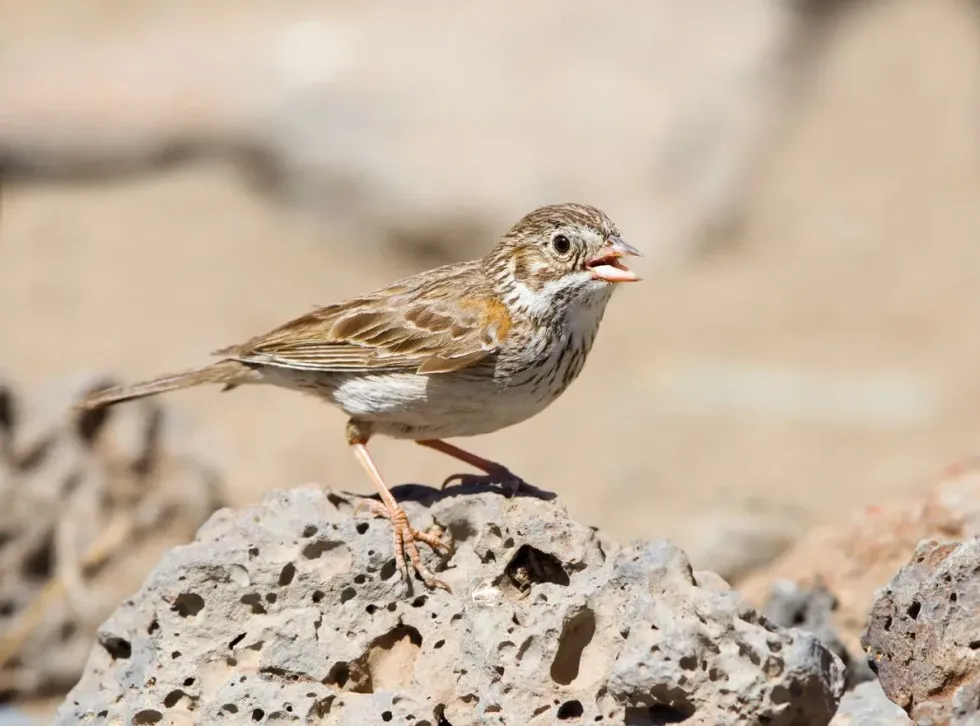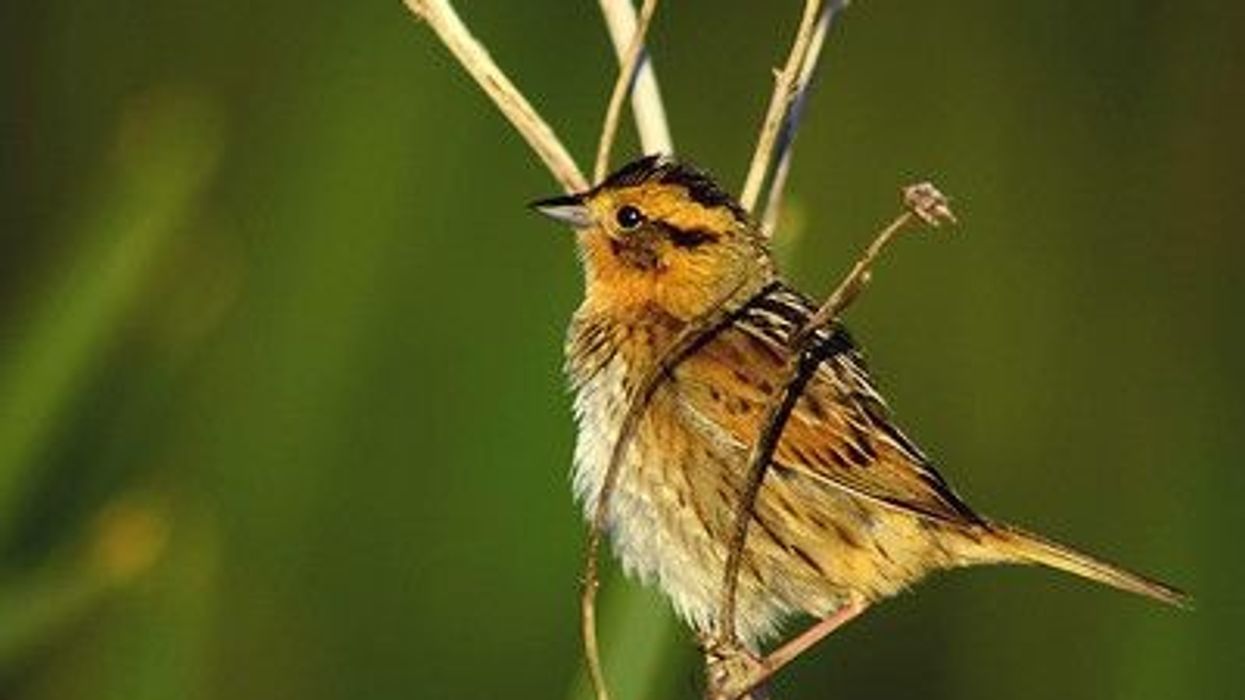These cute North American birds known as the vesper sparrow (Pooecetes gramineus) are fairly large-sized sparrows. Belonging to the order Passeriformes, family Passerellidae, these birds are also known as the New World sparrows.
These birds look really adorable with their small structure and gray-brown colored coat. They also have a thin eyering, which is a very discernible characteristic of this bird.
These are migratory birds. They migrate during their breeding season, starting from April to October.
Around this time, Oregon vesper sparrow, which is basically a subspecies of vesper sparrows, can be found in the Western part of Washington during this time of the year. More precisely, from April to September. During the winter they migrate to the Southern and central part of California.
Sadly, this adorable bird does not make an ideal house pet. Congested cages make them aggressive to such an extent that they start attacking other birds.
Vesper sparrows facts are interesting and fascinating. Keep on reading to learn more about this interesting species of bird.
Do you like to read about interesting birds around the world? Then don't forget to read these hornbill and lesser goldfinch facts.
Vesper Sparrow Interesting Facts
What type of animal is a vesper sparrow?
Vesper sparrows are adorable birds. Just as the name suggests, they belong to the species of sparrows. Although when compared to other sparrow species, they are fairly large in size.
What class of animal does a vesper sparrow belong to?
Vesper sparrows belong to the Aves class of the animal kingdom. Belonging to the order Passeriformes, family Passerellidae, these birds are also known as New World sparrows.
How many vesper sparrow are there in the world?
There are around 34 million vesper sparrows in the world. However, due to their habitat destruction, their population is decreasing with each passing day.
Where does a vesper sparrow live?
Their most preferred habitat is North America. These birds are abundantly found here. Their habitats consists of Canada, British-Columbia, California, Virginia, Arizona, Nova Scotia. During the breeding season, they migrate more towards the North. The migration starts in early spring. However, peak migration happens sometime from April to October.
What is a vesper sparrow's habitat?
Grassy areas are among the preferred areas of living for these birds. They can be found anywhere in pastures, beach grass, woodland clearings, meadows, sagebrush, old fields, hayfields, and dry grasslands.
Who do vesper sparrows live with?
These sparrows live in groups. These groups are also known as sparrow colonies. This is why many people install sparrow colony nesting boxes in their backyard garden.
How long does a vesper sparrow live?
It is not exactly known that how long vesper sparrows live. However, according to records, the oldest male vesper sparrow was seven years and one month old when he was captured and then released during the Colorado banding operations.
How do they reproduce?
The breeding season of these birds takes place from April to October. During the breeding season, these birds migrate more towards the north.
Surprisingly, and unlike the majority of birds, this species of sparrows build their nest in dry grassy land. The nest is basically a den created by the bird. This bird makes their nest somewhere near a vegetation patch using fine materials.
After breeding, the females lay around 2-5 eggs in the nest. The incubation period is of around 11-13 days, after which the eggs hatch. Although the young birds leave the nest after 7-13 days, it takes them along a month or more to learn to fly properly.
What is their conservation status?
According to the International Union for Conservation of Nature (IUCN) red list, their conservation status is Least Concerned. However, they are rapidly decreasing in number due to climate change. This climate change is reshaping their range in a negative way as they are facing major habitat loss.
Vesper Sparrow Fun Facts
What do vesper sparrows look like?

The vesper sparrow (Pooecetes gramineus) is a species of sparrows that mostly have gray-brown colored feathers, with an off-white abdomen and white outer tail feathers. Their white eye-ring, although very thin, is a distinct feature of their appearance. Another difficult to spot, yet distinctive, feature of their appearance is the chestnut patch on their shoulder.
How cute are they?
These North American birds look really cute. Their small structure, beautiful gray-brown colored feathers, and their sweet voice all adds to their cuteness.
How do they communicate?
Their means of communication with other species and themselves are through songs, also known as the vesper sparrow song. They use this song to create and defend territories and even to find mates during the breeding season.
How big is a vesper sparrow?
This species of sparrow comes under the large species of sparrows. They can grow 5.5-6.5 in (13-16 cm) in length. They are 1.2 times bigger than the LeConte's sparrow, which is the smallest species of sparrow.
How fast can a vesper sparrow fly?
Their flying speed has not yet been recorded.
How much does a vesper sparrow weigh?
The weight of this bird species falls somewhere between 0.7-1 oz (20-30 g).
What are their male and female names of the species?
There are no distinctive names for the male and female counterparts. Both are known as vesper sparrows.
What would you call a baby vesper sparrow?
There is no specific name for a baby vesper sparrow. Thus, similar to any other baby birds, their babies are also known as chicks.
What do they eat?
This is an omnivorous bird. They prey upon beetles, grasshoppers, caterpillars, and other sorts of insects. They also feed on the grass, seeds, and grain crops.
Are they dangerous?
Under no circumstance, this bird can be called dangerous. They are rather sweet and cause no harm to humans.
Would they make a good pet?
Although they look absolutely adorable, they might not be the ideal choice for a house pet. They do not adapt well to cages and can become so aggressive that they may even attack or kill other birds.
Did you know...
Hot temperatures are not ideal for the vesper sparrows. As the climate is changing at a high pace, and temperature is rising rapidly, due to global warming, this poses a serious threat to this bird species. Their population has decreased by 30% within a time span of 44 years (between 1970-2014).
The vesper sparrow's call
A vesper sparrow call is basically the song they sing during the early hours of the day, and even during the evening. This song serves a lot of purposes, starting from creating and defending territory to searching for a mate during the breeding season.
The vesper sparrow's migration
Vesper sparrows migrate during the breeding season. The migration takes place during early spring and happened till late fall. However, the peak migration takes place during the months of April to October.
Here at Kidadl, we have carefully created lots of interesting family-friendly animal facts for everyone to discover! Learn more about some other birds including western meadowlark, or common blackbird.
You can even occupy yourself at home by drawing one on our Vesper sparrow coloring pages.










